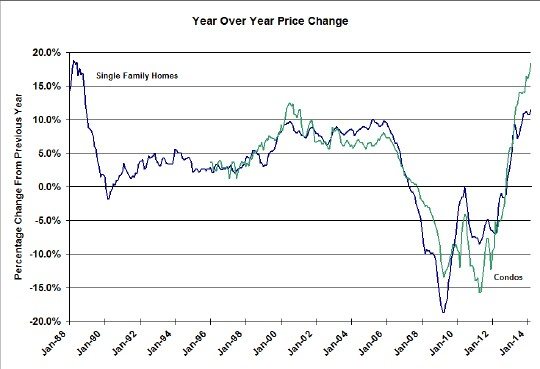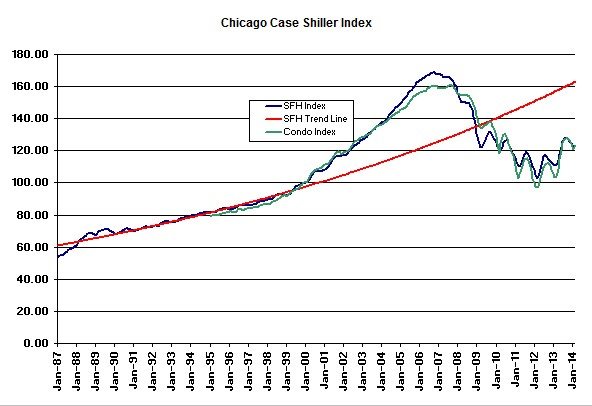Chicago home prices have been on a real tear lately, soaring ahead of last year by new record percentages each month. March was no exception, with this morning’s release of the Case Shiller home price index. This is the time of year when prices normally start to reverse and go back up with the spring selling season. Last March single family home prices were flat relative to February but this March was up so that’s what drove the year over year comparisons to a 25 year record high. It was a similar story for Chicago condominium prices, which also rose by more than they did last year, also setting a record for year over year appreciation since the index was first tracked.
Check out the graph below which shows just how dramatically both of these indices for Chicago have grown year over year. Single family home prices were up by 11.5%, while condominium prices were up by an eye popping 18.4%. This really shouldn’t come as a surprise in light of the extremely low inventory levels in the city. Eventually something has to give.
The graph below shows the actual Case Shiller index for Chicago since inception along with the long term trend line in red, which is based upon the growth rate exhibited prior to the bubble. March single family home prices were up by 0.7% from February and condo prices were up by a much larger 1.8%. That still leaves us 26.8% below the bubble peak for single family home prices and 23.5% below the condo peak although the two indices have risen by 20.0% and 26.6% respectively from the bottom of the market.
But it’s probably more realistic to compare the current price level to that long term trend line and on that basis Chicago single family home prices are still lagging by 24.3%. That leaves the average homeowner who bought a single family home in August 2002 or May 2009 back to where they started from – a really long time to go with no price appreciation. For condominium owners those dates are more like June 2002 or February 2010.
Chicago has actually been lagging many parts of the country in terms of it’s home price appreciation but now looks like it might be catching up since the rest of the nation actually slowed down a bit in March. As David M. Blitzer, Chairman of the Index Committee at S&P Dow Jones Indices, said of the national picture:
The year-over-year changes suggest that prices are rising more slowly. Annual price increases for the two Composites have slowed in the last four months and 13 cities saw annual price changes moderate in March. The National Index also showed decelerating gains in the last quarter. Among those markets seeing substantial slowdowns in price gains were some of the leading boom-bust markets including Las Vegas, Los Angeles, Phoenix, San Francisco and Tampa.
He also expressed caution in the outlook for the nation’s housing market:
Housing indicators remain mixed. April housing starts recovered the drop in March but virtually all the gain was in apartment construction, not single family homes. New home sales also rebounded from recent weakness but remain soft. Mortgage rates are near a seven month low but recent comments from the Fed point to bank lending standards as a problem. Other comments include arguments that student loan debt is preventing many potential first time buyers from entering the housing market.
If you want to keep up to date on the Chicago real estate market, get an insider’s view of the seamy underbelly of the real estate industry, or you just think I’m the next Kurt Vonnegut you can Subscribe to Getting Real by Email. Please be sure to verify your email address when you receive the verification notice.

